
Geospatial Technologies for Land Degradation Assessment and Management
Crc Press Inc (Verlag)
978-1-4987-4960-2 (ISBN)
"Geospatial Technology for Land Degradation Assessment and Management" uses satellite imagery and remote sensing technologies to measure landscape parameters and terrain attributes. Remote sensing and geospatial technologies are important tools in assessing the extent and the severity of land and soil degradation, their temporal changes, and geospatial distribution in a timely and cost-effective manner.
The knowledge presented in the book by Dr. R.S. Dwivedi shows how remote sensing data can be utilized for inventorying, assessing, and monitoring affected ecosystems and how this information can be integrated in the models of different local settings. Through many land degradations studies, land managers, researchers, and policymakers will find practical applications of geospatial technologies and future challenges. The information presented is also relevant to advancing the Sustainable Development Goals of the United Nations towards global food security.
Dr Ravi Shankar Dwivedi is a consultant and guest faculty at Jawaharlal Nehru Technological University Hyderabad, India. He is an expert Land resources management: Soil resources inventory, mapping and monitoring land degradation/ desertification, wastelands and land use/ land cover using a variety of remote sensing data. He has a long experience also in Watershed management- Generation of inputs especially soil resources, land capability and land irrigability maps, surface water bodies maps and drainage maps ; integration of these maps with hydrogeoplogical maps and development of action plan, monitoring and impact assessment using multi-temporal satellite and ancillary data.He holds Awards from Indian Society of Remote Sensing for outstanding contribution in the field of remote sensing and Doreen Mashler Team Award for outstanding contribution to integrated watershed management for sustainable development (as a member of ICRISAT team).
1 An Introduction to Geospatial Technology. 2 Passive Remote Sensing. 3 Active Remote Sensing. 4 Digital Image Processing. 5 An Introduction to Land Degradation. 6 Water Erosion. 7 Wind Erosion. 8 Soil Salinization and Alkalinization. 9 Soil Acidification. 10 Waterlogging. 11 Land Degradation due to Mining, Aquaculture, and Shifting Cultivation. 12 Drought. 13 Land Degradation Information Systems.
| Erscheinungsdatum | 19.10.2018 |
|---|---|
| Zusatzinfo | 27 Tables, black and white; 178 Illustrations, black and white |
| Verlagsort | Bosa Roca |
| Sprache | englisch |
| Maße | 178 x 254 mm |
| Gewicht | 884 g |
| Themenwelt | Naturwissenschaften ► Biologie ► Ökologie / Naturschutz |
| Naturwissenschaften ► Geowissenschaften ► Geografie / Kartografie | |
| Naturwissenschaften ► Geowissenschaften ► Geologie | |
| Technik ► Umwelttechnik / Biotechnologie | |
| ISBN-10 | 1-4987-4960-7 / 1498749607 |
| ISBN-13 | 978-1-4987-4960-2 / 9781498749602 |
| Zustand | Neuware |
| Informationen gemäß Produktsicherheitsverordnung (GPSR) | |
| Haben Sie eine Frage zum Produkt? |
aus dem Bereich


